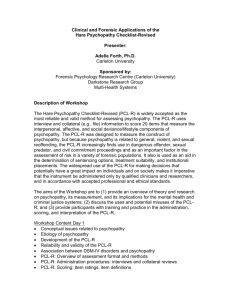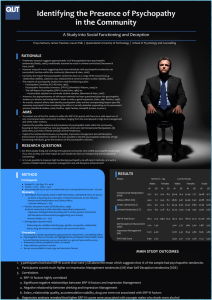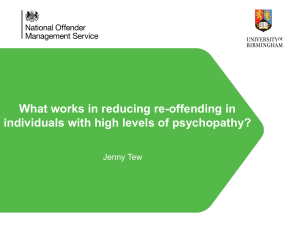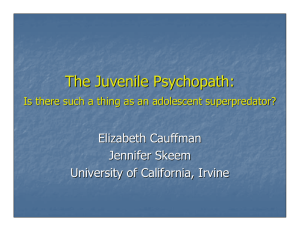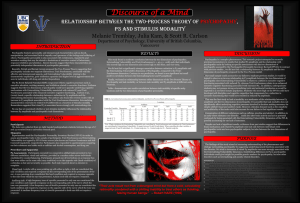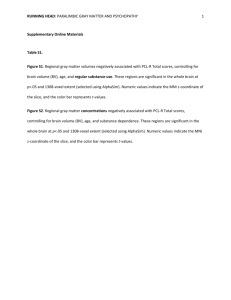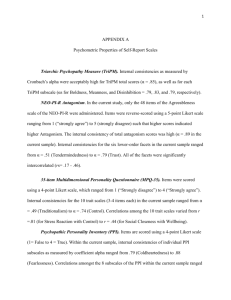Unresolved Controversies Concerning Psychopathy
advertisement
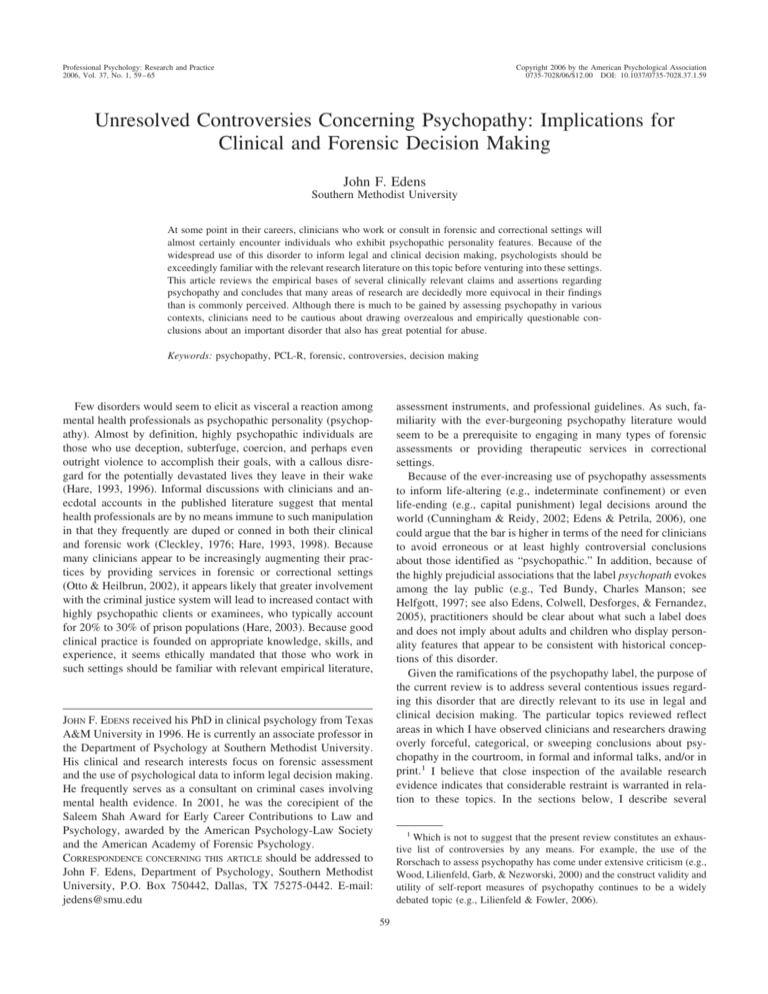
Professional Psychology: Research and Practice 2006, Vol. 37, No. 1, 59 – 65 Copyright 2006 by the American Psychological Association 0735-7028/06/$12.00 DOI: 10.1037/0735-7028.37.1.59 Unresolved Controversies Concerning Psychopathy: Implications for Clinical and Forensic Decision Making John F. Edens Southern Methodist University At some point in their careers, clinicians who work or consult in forensic and correctional settings will almost certainly encounter individuals who exhibit psychopathic personality features. Because of the widespread use of this disorder to inform legal and clinical decision making, psychologists should be exceedingly familiar with the relevant research literature on this topic before venturing into these settings. This article reviews the empirical bases of several clinically relevant claims and assertions regarding psychopathy and concludes that many areas of research are decidedly more equivocal in their findings than is commonly perceived. Although there is much to be gained by assessing psychopathy in various contexts, clinicians need to be cautious about drawing overzealous and empirically questionable conclusions about an important disorder that also has great potential for abuse. Keywords: psychopathy, PCL-R, forensic, controversies, decision making assessment instruments, and professional guidelines. As such, familiarity with the ever-burgeoning psychopathy literature would seem to be a prerequisite to engaging in many types of forensic assessments or providing therapeutic services in correctional settings. Because of the ever-increasing use of psychopathy assessments to inform life-altering (e.g., indeterminate confinement) or even life-ending (e.g., capital punishment) legal decisions around the world (Cunningham & Reidy, 2002; Edens & Petrila, 2006), one could argue that the bar is higher in terms of the need for clinicians to avoid erroneous or at least highly controversial conclusions about those identified as “psychopathic.” In addition, because of the highly prejudicial associations that the label psychopath evokes among the lay public (e.g., Ted Bundy, Charles Manson; see Helfgott, 1997; see also Edens, Colwell, Desforges, & Fernandez, 2005), practitioners should be clear about what such a label does and does not imply about adults and children who display personality features that appear to be consistent with historical conceptions of this disorder. Given the ramifications of the psychopathy label, the purpose of the current review is to address several contentious issues regarding this disorder that are directly relevant to its use in legal and clinical decision making. The particular topics reviewed reflect areas in which I have observed clinicians and researchers drawing overly forceful, categorical, or sweeping conclusions about psychopathy in the courtroom, in formal and informal talks, and/or in print.1 I believe that close inspection of the available research evidence indicates that considerable restraint is warranted in relation to these topics. In the sections below, I describe several Few disorders would seem to elicit as visceral a reaction among mental health professionals as psychopathic personality (psychopathy). Almost by definition, highly psychopathic individuals are those who use deception, subterfuge, coercion, and perhaps even outright violence to accomplish their goals, with a callous disregard for the potentially devastated lives they leave in their wake (Hare, 1993, 1996). Informal discussions with clinicians and anecdotal accounts in the published literature suggest that mental health professionals are by no means immune to such manipulation in that they frequently are duped or conned in both their clinical and forensic work (Cleckley, 1976; Hare, 1993, 1998). Because many clinicians appear to be increasingly augmenting their practices by providing services in forensic or correctional settings (Otto & Heilbrun, 2002), it appears likely that greater involvement with the criminal justice system will lead to increased contact with highly psychopathic clients or examinees, who typically account for 20% to 30% of prison populations (Hare, 2003). Because good clinical practice is founded on appropriate knowledge, skills, and experience, it seems ethically mandated that those who work in such settings should be familiar with relevant empirical literature, JOHN F. EDENS received his PhD in clinical psychology from Texas A&M University in 1996. He is currently an associate professor in the Department of Psychology at Southern Methodist University. His clinical and research interests focus on forensic assessment and the use of psychological data to inform legal decision making. He frequently serves as a consultant on criminal cases involving mental health evidence. In 2001, he was the corecipient of the Saleem Shah Award for Early Career Contributions to Law and Psychology, awarded by the American Psychology-Law Society and the American Academy of Forensic Psychology. CORRESPONDENCE CONCERNING THIS ARTICLE should be addressed to John F. Edens, Department of Psychology, Southern Methodist University, P.O. Box 750442, Dallas, TX 75275-0442. E-mail: jedens@smu.edu 1 Which is not to suggest that the present review constitutes an exhaustive list of controversies by any means. For example, the use of the Rorschach to assess psychopathy has come under extensive criticism (e.g., Wood, Lilienfeld, Garb, & Nezworski, 2000) and the construct validity and utility of self-report measures of psychopathy continues to be a widely debated topic (e.g., Lilienfeld & Fowler, 2006). 59 EDENS 60 conclusions about psychopathy that appear difficult to defend empirically, I briefly summarize evidence bearing on these issues, and I highlight some of the practice implications of what I argue to be more qualified but defensible interpretations of the current literature. By highlighting some of the current limitations of what is known about psychopathy, I hope that practitioners can avoid possible abuses of what Hare (1998) described as “the single most important clinical construct in the criminal justice system” (p. 99). “Once a Psychopath, Always a Psychopath” The Controversy The position that psychopathy is remarkably stable over time underlies much that has been written about this disorder in that it is argued essentially to reflect a dispositional, immutable personality constellation (e.g., Gacono, 2000). One version of the “immutable personality” assertion applies to the developmental trajectory of children. Unlike Athena, highly psychopathic adults do not spring forth fully formed from the head of Zeus—this is clear. Existing evidence suggests that adults who obtain high scores on the most widely studied measure of psychopathy, the Psychopathy Checklist–Revised (PCL-R; Hare, 2003), start showing some signs of the characteristic traits and behaviors at a relatively early age. In fact, the scoring of some PCL-R items is based specifically on such conduct. It cannot be stated emphatically enough that these findings do not lead to the inevitable conclusion that the presence of psychopathic-looking “traits” among children and adolescents will ultimately result in adults who continue to demonstrate these traits and behaviors (Edens, Skeem, Cruise, & Cauffman, 2001; Hart, Watt, & Vincent, 2002).2 The field lacks any significant longitudinal research regarding the stability of these traits, although the available evidence suggests that more extreme scores identified among young children in particular may regress toward the mean in many instances (e.g., Frick, Kimonis, Dandreaux, & Farell, 2003; see also Cauffman & Skeem, 2004). The second version of the immutability argument relates to adults. Cross-sectional studies clearly indicate that there are older individuals in prison settings who exhibit psychopathic traits to a considerable degree, although as a group these older individuals display somewhat lower scores on the factor of the PCL-R (Factor 2) more strongly wedded to impulsivity, social deviance, and violence (Hare, 2003). The available research by definition comes from offenders who are in prison settings—perhaps specifically because they have committed serious criminal acts relatively late in life. There are no well-controlled longitudinal studies that have followed young, highly psychopathic adults to determine whether they in fact are very likely to end up as highly psychopathic adults much later in life. The closest approximation to such a study was conducted by Rutherford, Cacciola, Alterman, McKay, and Cooke (1999) with 200 male and 25 female methaodone patients over a 2-year follow-up. Intraclass correlations for dichotomous classifications and continuous PCL-R scores ranged from .48 to .67. Although generally supportive of a relative degree of stability at the group level, such results offer little support for arguments regarding the immutability of psychopathy. Practice Implications Certainly the early onset of severe callousness, egocentricity, and other characteristics or behaviors similar to adult psychopathy should not be ignored or dismissed. Neither should they be asserted to portend an ominous downward spiral that will inevitably lead to adult psychopathy, particularly given the developmental fluidity of childhood and adolescent characteristics such as grandiosity, impulsivity, and irresponsibility (Edens, Skeem, et al., 2001; Frick et al., 2003). In settings in which the presumed stability of a “bad character” may have profound weight in terms of subsequent treatment and rehabilitation efforts (e.g., waiving adolescent offenders out of the juvenile and into the adult criminal justice system), mental health examiners should be forthcoming about how little is actually known about the stability of these characteristics among children and adolescents. In relation to adults, examiners would do well to avoid longitudinal claims about the constancy of a particular individual’s psychopathic traits when these claims are based on cross-sectional studies of PCL-R scores across highly select samples of prison inmates and forensic patients (see the “Psychopaths Cannot Be Treated” section below as well). “Where the Psychopath Goes, Violence Will Surely Follow” The Controversy One could argue that the extensive attention given to psychopathy over the last few decades has been largely attributable to its association with violence. In fact, some commentators have even described the PCL-R as the “unparalleled” measure of violence risk (Salekin, Rogers, & Sewell, 1996; cf. Gendreau, Goggin, & Smith, 2002; Walters, 2003)—a position that also has been frequently endorsed in court cases (e.g., R. v. K.S., 2004; R. v. LaRue, 2003). In many contexts, clinicians should be encouraged to consider the presence of psychopathic traits when attempting to assess the likelihood that someone may act out aggressively, particularly when one considers the recurrent finding that clinicians routinely focus on violence-risk factors that have little or no empirical support (e.g., Elbogen, Mercado, Scalora, & Tomkins, 2002). Although it would be defensible, in the aggregate, to conclude that elevated PCL-R scores identify individuals who may be more violence-prone, the problem with such assertions in individual cases is that examinees are never in aggregate contexts. Although several meta-analyses (e.g., Gendreau et al., 2002; Walters, 2003) and other large-scale studies have demonstrated that psychopathy typically is associated with higher rates of violent and other forms of criminal conduct in the community, such probabilistic findings obviously do not support absolutistic assertions made by some examiners that individuals who are psychopathic will necessarily engage in violent conduct in the future. More important, the “average” association between psychopathy and violence in these meta-analyses belies the fact that across studies the strength of this relationship is remarkably heterogeneous. The implication here is that one should not discuss the “global” relationship between psychopathy and violence but, instead, should consider other factors (e.g., context) that might help practitioners and researchers 2 When confronted with this logical fallacy (affirming the consequent), a useful strategy is to ask whether because all adult psychopathic offenders ate baby food as infants, eating baby food would be expected to be a good predictor of adult psychopathy. CONTROVERSIES CONCERNING PSYCHOPATHY better understand why such variability exists across different populations and settings. As an example of the importance of context in risk assessment, it is worth noting that highly psychopathic individuals often end up in environments specifically designed to inhibit violence (e.g., maximum-security prisons), which of course may reduce the number of opportunities to act out. Even when acting out does occur, however, there is growing evidence that psychopathy may not be a particularly useful risk factor in U.S. prison systems. For example, Guy, Edens, Anthony, and Douglas (2005) recently reported mean meta-analytic correlations between the PCL measures and prison violence that were considerably weaker in studies of U.S. prisoners (rw ⫽ .10) than in studies of non-U.S. prisoners (rw ⫽ .24).3 Another issue of contention in relation to the “psychopathy equals violence” argument relates to assertions that psychopathic individuals are highly prone to serious aggression even beyond the age when most criminals tend to “burn out.” This is an issue that arises in death penalty cases in which an offender might be released after serving a 30-year sentence in some jurisdictions (Cunningham & Reidy, 2002; Edens, Petrila, & BuffingtonVollum, 2001). Support for this position perhaps stems most directly from an early study by Hare, Forth, and Strachan (1992), in which they concluded that “the psychopath’s propensity for violence and aggression may be relatively persistent across much of the life span” (p. 295). One other small study (Harris, Rice, & Cormier, 1991) reported that psychopathic inmates over the age of 40 were more likely to reoffend violently than were comparably aged nonpsychopathic offenders. Despite these early findings, one large-scale subsequent study has failed to replicate these results (Porter, Birt, & Boer, 2001 [see Figure 1, p. 654; also see Figure 2, p. 655]), and a reanalysis of the Hare et al. (1992) results also strongly contradicted the “persistent-violence” assertion (Edens, Petrila, & Buffington-Vollum, 2001).4 Practice Implications The fact that the magnitude of the psychopathy–violence association has varied widely from study to study would seem to compel examiners to be very specific about exactly what types of settings and circumstances are being considered when making statements about risk for future violence. For example, in relation to U.S. prisons, it would seem hard to defend using the PCL-R in an attempt to identify inmates who are likely to be violent given the modest relationship noted in the literature. Even if statistically significant because of large sample sizes, a correlation of .10 (Guy et al., 2005) indicates that a large number of false positives will occur if the PCL-R is used to sort individuals into higher versus lower risk groups. Additionally, at present there is no evidence to suggest that practitioners should be using psychopathy scores to make predictions regarding the likelihood of violent behavior literally decades later. Even if a highly psychopathic 50-year-old prison inmate were at increased risk for violence if released into the community, that does not imply that a highly psychopathic 20-year-old inmate will continue to be at increased risk for violence if released at the age of 50. The relevance of including the PCL-R when assessing recidivism risk for an older offender seems questionable at best at present, and assessing risk in a 20-year-old to ascertain whether he 61 or she may be violent 30 years later is clearly guesswork that presently lacks any scientific foundation. When using the PCL-R, it would be helpful if examiners provided descriptive information to the consumers of their evaluations regarding exactly how useful particular correlational results are in relation to the specific contexts and samples under consideration. For example, in a large sample of British prison inmates, Hare, Clark, Grann, and Thornton (2000) reported that 42% of those with elevated PCL-R scores committed an assault in prison, whereas only 16.4% of those with lower scores engaged in such institutional misconduct. Similarly, Edens, Buffington-Vollum, Keilen, Roskamp, and Anthony (2005) recently noted that across three U.S. prison samples in which the base rate of violent infractions was 22.2% for the entire group (N ⫽ 293), only 25% of the psychopathic offenders committed such an infraction. Descriptive values such as these arguably are much more informative for laypersons than are the more complex summary statistics (e.g., receiver operating characteristic curves, biserial correlations) typically reported in most research studies. Unfortunately, descriptive statistics often are not provided in these studies. A final point to note is that even if an examiner deems psychopathy relevant to include in a risk assessment, it seems untenable that someone would ever rely solely on the PCL-R, because there are certainly instances in which low scores cannot be equated with low risk (see Hare, 1998, for examples) and other circumstances where high scorers can be managed successfully without major incident (Cooke, 1997; Hare et al., 2000). Practitioners may well need to consider the relevance of psychopathy when asked to make inferences about risk for violence and criminality, but they should never base their opinions exclusively on PCL-R measures when conducting such work (Hemphill & Hare, 2004). For a useful example of how the PCL-R may be incorporated with other risk factors, interested readers should examine the HCR–20 (Webster, Douglas, Eaves, & Hart, 1997). “Psychopaths Cannot Be Treated” The Controversy This position has been espoused with varying degrees of certainty by mental health experts and judges in criminal proceedings (e.g., Barefoot v. Estelle, 1983; U.S. v. Stitt, 1998) and in published research reviews (e.g., Gacono, Nieberding, Owen, Rubel, & Bod3 These meta-analytic findings stand in sharp contrast to some of the opinions offered by prosecution experts in capital trials. Although not based on the PCL-R per se, testimony in the now infamous Barefoot v. Estelle (1983) case represents perhaps the most extreme form of overreaching that has been documented. In response to a description of a hypothetical offender with a criminal history similar to the defendant, James Grigson asserted that such a person would be a sociopath of the “most severe category” (p. 919) and that there was a “one hundred percent and absolute” (p. 919) chance that he would commit future acts of violence— even if in prison. As empirically unsupportable as this conclusion was (Cunningham & Reidy, 2002), the U.S. Supreme Court’s affirmative decision gave experts considerable latitude to opine with great certainty about violence risk posed by criminal defendants, a precedent that still holds today. 4 Edens, Petrila, and Buffington-Vollum (2001) reported that in the combined 41–50-year-old age range, the rates of violent reoffending were 11.6% for the psychopathic and 7.4% for the nonpsychopathic groups (ns). EDENS 62 holdt, 1997). Gacono et al. (1997), in fact, argued that there was “nothing the behavioral sciences can offer for treating those with psychopathy” (p. 119). This conclusion seems to have taken hold in some arenas in that high PCL-R scores increasingly serve as the rationale for denying treatment services to some offenders (D’Silva, Duggan, & McCarthy, 2004). The “cannot-be-treated” argument is driven mostly by a consideration of research suggesting that adults and adolescents with elevated scores on the PCL-R measures are less likely to respond to the types of interventions that have been investigated in the past (e.g., Hare et al., 2000). Although it would be hard to argue that psychopathy does not raise serious concerns about treatment responsiveness, the certitude of negative outcomes has been challenged by recent reviews (D’Silva et al., 2004) and research findings (Cooke, 1997; Skeem, Monahan, & Mulvey, 2002). Most of the earlier outcome studies with psychopathic offenders were methodologically weak, and none appear to have been based on rehabilitation principles that have shown some degree of efficacy among criminals (see Dowden & Andrews, 2000, for a meta-analytic review of the offendertreatment literature). Additionally, one widely cited program involved “novel” interventions that would be considered unethical by today’s standards (see Harris, Rice, & Cormier, 1994, for an extensive review of a program that involved, among other “treatments,” marathon nude encounter groups). Practice Implications Therapeutic nihilism, although perhaps understandable given the affective and interpersonal traits associated with psychopathy, would seem to be somewhat premature in relation to the treatment and management of psychopathic individuals. Moreover, promising alternative intervention strategies (e.g., Wong & Hare, in press) have yet to be investigated in any systematic fashion. It may very well be that psychopathic offenders ultimately will need some type of intervention that is fundamentally different from what has been demonstrated to be effective with inmates in general. At present, however, it is not even known whether effective rehabilitation methods will have some impact with this subgroup of offenders, because such programs have yet to be studied. Regarding clinical opinions about treatment responsiveness, in relation to adult offenders it would seem defensible for examiners to assert that there is no known intervention that has been shown to be particularly effective with individuals high in psychopathic traits, although there appears to be some evidence that psychiatric patients high in psychopathic traits who can be engaged in treatment may respond in a positive fashion (Skeem et al., 2002). Practitioners also should be aware, however, that therapist impressions of “positive treatment outcome” should not be assumed to reflect actual positive treatment outcome—at least one study of sex offenders found that psychopathic individuals who were presumed to have benefited from treatment were at heightened risk for criminal recidivism (Seto & Barbaree, 1999).5 “Clinical Evaluations of Psychopathy Are Highly Reliable” The Controversy This position, which is a quite reasonable summary of published research studies, is a potential source of confusion in applied settings where individual PCL-R ratings are being considered. Results summarized in the most recent PCL-R manual (Hare, 2003) clearly suggest that well-trained examiners can score the PCL-R and its derivatives reliably, particularly when there is considerable file information available to inform these ratings. The standard error of measurement (SEM) for the PCL-R reported in the new manual ranges from 2.7 to 3.4, depending on the sample and the scoring method used. Despite these encouraging findings, such results do not lead to the inevitable conclusion that a particular PCL-R score is a close approximation of any given offender’s “true” level of psychopathy— especially in highly adversarial settings. In fact, examples of rather significant disagreements in the scoring of the PCL-R are evident in several legal cases (see, e.g., R. v. K.S., 2004, in which one examiner indicated that the defendant’s PCL-R score fell at the 32nd percentile, whereas the other argued it was at the 91st percentile). Although there are several potential explanations for such discrepancies (e.g., poorly trained examiners), one possibility is that in some cases there simply may be inadequate information upon which to make reliable ratings. Related to this latter issue, an interesting and apparently unexplored area of clinical practice is at what point examiners believe they have sufficient information to score psychopathy scales (Edens & Petrila, 2006). The PCL-R manual (Hare, 2003) is clear that it should not be used absent sufficient file information, but it is not entirely clear on what constitutes “sufficient” in any given case. Practice Implications Although there is no mandated level of training that individual examiners should have prior to using the PCL-R or its derivatives in applied settings (Hare, 2003), clearly it is not an instrument that can simply be “bought and used.” The PCL-R manual provides excellent guidance in terms of what sorts of background and training experiences are needed prior to using this instrument, but it is apparent that examiners have misused the PCL-R and made ratings that were quite suspect in some cases (Edens, 2001; Hare, 1998). One potentially useful modification of current practices would be to report PCL-R scores with a confidence interval rather than as simply a number (Edens & Petrila, 2006). Consistent with Hare’s (2003, pp. 66 – 67) description of the expected range in which an examinee’s “true” score is likely to fall, this procedure would help the psychometrically unsophisticated understand that such assessment results are subject to a certain degree of imprecision or error, even under the best of circumstances. For example, on the basis of SEMs reported in the manual the 95% confidence interval for a hypothetical PCL-R score of 25 for a male offender would be approximately 19 –31.6 Aside from perhaps fostering a more realistic appraisal of the stability of psychopathy scores among laypersons who review such information (e.g., jurors), such score ranges also might be helpful for countering criticisms when cross5 Despite this finding, which has been widely cited in the literature, Barbaree (2005) recently published an extended follow-up study on this sample that found that treatment behavior was unrelated to recidivism. 6 In a blatant distortion of the stability of a psychopathy score, I recently observed an expert testify to a jury that his PCL-R rating of a defendant CONTROVERSIES CONCERNING PSYCHOPATHY 63 examination suggests that a particular item score for an examinee is questionable. ation’s (2001) recommendations regarding the use of nonstigmatizing language (see also Forth, Kosson, & Hare, 2003). “Psychopaths Are Qualitatively Different From Other Offenders” Concluding Remarks The Controversy It has been argued by some commentators that psychopaths “comprise a discrete natural class of individuals” (Harris, Skilling, & Rice, 2001, p. 197). This conclusion is driven in large part by a widely cited article by Harris, Rice, and Quinsey (1994) in which they claimed to identify a latent taxon on the PCL-R in a large Canadian sample of forensic patients using complex statistical procedures first developed by Paul Meehl and his colleagues. Although perhaps an intuitively appealing position that helps to psychologically distance the psychopathic offender from the rest of society, blanket assertions that psychopaths are a “discrete natural class” are much more questionable than would be gleaned from the Harris et al. (2001) review. More recent taxometric studies using both the PCL-R and other psychopathy measures have been much more consistent with the argument that psychopaths differ from other offenders in degree rather than in kind (Edens, Marcus, Lilienfeld, & Poythress, in press; Guay, Ruscio, Hare, & Knight, 2004; Marcus, John, & Edens, 2004; cf. Skilling, Quinsey, & Craig, 2001). Practice Implications At first glance, taxometric debates may seem to be something of an ivory tower topic that is far removed from clinical practice— particularly given that identifying a particular class of individuals on the basis of even an arbitrarily defined score may be useful for applied decision-making purposes (e.g., identifying an optimal PCL-R score to differentiate more vs. less violence-prone offenders). Despite this, I believe there are clear real-world implications regarding this controversy. For example, referring to an examinee or client as “a psychopath” implies a dichotomous distinction between those who “are” and those who “are not” psychopaths, despite the markedly inconsistent findings in the available scientific studies on this topic. Moreover, many legal decision makers already seem to have either implicitly or explicitly adopted this categorical model, reflected in recurrent debates in court cases regarding whether a particular defendant is “diagnosable” as a psychopath (i.e., is 30 or above on the PCL-R). As noted earlier, if examiners were to focus attention on confidence intervals rather than on raw scores or categorical placements, perhaps decision makers would be less preoccupied with the difference between a score of 29 and a score of 30 on this instrument (Edens & Petrila, 2006). Finally, even if psychopathy were ultimately found to be taxonic, from a semantic perspective, referring to individuals by their disorder or diagnosis (e.g., “the schizophrenic,” “the retardate”) only encourages others to define such persons by their pathology rather than seeing them as an individual with such a condition. Although referring to offenders with an elevated score on the PCL-R as “highly psychopathic” or “high in psychopathic traits” may seem less attractive to some, terminology such as “the psychopath” is inconsistent with the American Psychological Associ- The PCL-R is a widely used and valuable instrument, but like any assessment procedure, it can be misused or oversold in various ways to support numerous objectives. In hindsight, the areas of concern noted above would seem to reflect two general themes related to potential overreaching on the part of mental health experts that are not unique to psychopathy per se. The first is the longstanding nomothetic-versus-idiographic problem of what types of conclusions or predictions are appropriate to make about individuals on the basis of group-level data. This problem is evident in relation to making statements about the stability or treatability of psychopathy as well as regarding the likelihood of future violence. Categorical predictions (e.g., “This individual will/will not be violent in the future”) based on psychopathy ratings go well beyond what reasonably can be concluded on the basis of the probabilistic nature of this relationship—and the probabilistic relationship itself seems to vary widely from one study to the next. The second general theme is the effect of working in an adversarial criminal context, where there is a press to move from objective “expert” neutrality toward asserting positions or opinions that are most favorable to the side that has retained the clinician, or at least asserting them in the most favorable way possible (Shuman & Greenberg, 2003). As such, it is perhaps not entirely surprising that examiners might be somewhat prone to draw conclusions or make assertions that overstate or perhaps misconstrue what is currently known about this particularly troubling personality disorder. There is ample evidence that the objectivity of mental health experts already is viewed with considerable skepticism in the legal system (e.g., Otto & Heilbrun, 2002), however, and drawing definitive conclusions about topics that can easily be demonstrated to be at least very controversial will only undermine experts’ credibility and give further ammunition to those who question whether mental health professionals should be involved in the legal system (e.g., Hagen, 1997). As a final point, I would suggest that some of what drives what I perceive to be the overzealousness about psychopathy is the desire of some professionals to bolster the relevance of clinical psychology in forensic and correctional decision making, where its contributions over the past few decades have been (somewhat speciously, I would argue) devalued (see, generally, Andrews, Bonta, & Hoge, 1990). A PCL-R score is not a simple actuarial checklist that can be completed by a correctional technician with minimal training. It reflects a complex psychological construct that is not easily dismissed or explained by most sociological and criminological models of crime and violence, which typically minimize the role of individual differences. But the PCL-R is only one tool in the armamentarium of the forensically proficient clinician (Otto & Heilbrun, 2002), who should be well versed in its strengths and limitations. Ten years ago, Hare (1996) asserted that psychopathy was “a clinical construct whose time has come” (p. was highly reliable and that, if 100 other examiners readministered it, 90 of them would give him the exact same score. EDENS 64 25). Let us hope that in the next decade it does not become, because of overly enthusiastic misapplication, a clinical construct in need of restraint. References American Psychological Association. (2001). Publication manual of the American Psychological Association (5th ed.). Washington, DC: Author. Andrews, D. A., Bonta, J., & Hoge, R. D. (1990). Classification for effective rehabilitation: Rediscovering psychology. Criminal Justice and Behavior, 17, 19 –52. Barbaree, H. E. (2005). Psychopathy, treatment behavior, and recidivism: An extended follow-up of Seto and Barbaree. Journal of Interpersonal Violence, 20, 1115–1131. Barefoot v. Estelle, 463 U.S. 880 (1983). Cauffman, E., & Skeem, J. (2004, March). The developmental (in)appropriateness of assessing juvenile psychopathy. In J. Skeem (Chair), Contemporary issues in juvenile psychopathy. Symposium conducted at the biennial meeting of the American Psychology-Law Society, Scottsdale, AZ. Cleckley, H. (1976). The mask of sanity (5th ed.). St. Louis, MO: Mosby. Cooke, D. J. (1997). The Barlinnie Special Unit: The rise and fall of a therapeutic experiment. In E. Cullen, L. Jones, & R. Woodward (Eds.), Therapeutic communities for offenders (pp. 101–120). New York: Wiley. Cunningham, M. D., & Reidy, T. J. (2002). Violence risk assessment at federal capital sentencing: Individualization, generalization, relevance, and scientific standards. Criminal Justice and Behavior, 29, 512–537. D’Silva, K., Duggan, C., & McCarthy, L. (2004). Does treatment really make psychopaths worse? A review of the evidence. Journal of Personality Disorders, 18, 163–177. Dowden, C., & Andrews, D. (2000). Effective correctional treatment and violent reoffending: A meta-analysis. Canadian Journal of Criminology, 42, 449 – 467. Edens, J. F. (2001). Misuses of the Hare Psychopathy Checklist–Revised in court: Two case examples. Journal of Interpersonal Violence, 16, 1082– 1093. Edens, J. F., Buffington-Vollum, J. K., Keilen, A., Roskamp, P., & Anthony, C. (2005). Predictions of future dangerousness in capital murder trials: Is it time to “disinvent the wheel”? Law and Human Behavior, 29, 55– 86. Edens, J. F., Colwell, L. H., Desforges, D. M., & Fernandez, K. (2005). The impact of mental health evidence on support for capital punishment: Are defendants labeled psychopathic considered more deserving of death? Behavioral Sciences and the Law, 23, 603– 625. Edens, J. F., Marcus, D. K., Lilienfeld, S. O., & Poythress, N. G. (in press). Psychopathic, not psychopath: Taxometric evidence for the dimensional structure of psychopathy. Journal of Abnormal Psychology. Edens, J. F., & Petrila, J. (2006). Legal and ethical issues in the assessment and treatment of psychopathy. In C. Patrick (Ed.), Handbook of psychopathy (pp. 573–588). New York: Guilford Press. Edens, J. F., Petrila, J., & Buffington-Vollum, J. K. (2001). Psychopathy and the death penalty: Can the Psychopathy Checklist–Revised identify offenders who represent “a continuing threat to society”? Journal of Psychiatry and Law, 29, 433– 481. Edens, J. F., Skeem, J. L., Cruise, K. R., & Cauffman, E. (2001). Assessment of “juvenile psychopathy” and its association with violence: A critical review. Behavioral Sciences and the Law, 19, 53– 80. Elbogen, E., Mercado, C., Scalora, M., & Tomkins, A. (2002). Perceived relevance of factors for violence risk assessment: A survey of clinicians. International Journal of Forensic Mental Health, 1, 37– 47. Forth, A., Kosson, D., & Hare, R. (2003). Psychopathy Checklist: Youth version. Toronto, Ontario, Canada: Multi-Health Systems. Frick, P. J., Kimonis, E. R., Dandreaux, D. M., & Farell, J. M. (2003). The 4 year stability of psychopathic traits in non-referred youth. Behavioral Sciences and the Law, 21, 713–736. Gacono, C. B. (2000). Preface. In C. Gacono (Ed.), The clinical and forensic assessment of psychopathy: A practitioner’s guide (pp. xv– xxii). Mahwah, NJ: Erlbaum. Gacono, C. B., Nieberding, R. J., Owen, A., Rubel, J., & Bodholdt, R. (1997). Treating conduct disorder, antisocial, and psychopathic personalities. In J. Ashford, B. D. Sales, & W. H. Reid (Eds.), Treating adult and juvenile offenders with special needs (pp. 99 –129). Washington, DC: American Psychological Association. Gendreau, P., Goggin, C., & Smith, P. (2002). Is the PCL-R really the “unparalleled” measure of risk? A lesson in knowledge cumulation. Criminal Justice and Behavior, 29, 397– 426. Guay, J., Ruscio, J., Hare, R., & Knight, R. A. (2004, October). The latent structure of psychopathy: When more is simply more. Paper presented at the 19th Annual Meeting of the Society for Research in Psychopathology, St. Louis, MO. Guy, L. G., Edens, J. F., Anthony, C., & Douglas, K. S. (2005). Does psychopathy predict institutional misconduct among adults? A metaanalytic investigation. Journal of Consulting and Clinical Psychology, 73, 1056 –1064. Hagen, M. (1997). Whores of the court: The fraud of psychiatric testimony and the rape of American justice. New York: HarperCollins. Hare, R. D. (1993). Without conscience: The disturbing world of the psychopaths among us. New York: Guilford Press. Hare, R. D. (1996). Psychopathy: A clinical construct whose time has come. Criminal Justice and Behavior, 23, 25–54. Hare, R. D. (1998). The Hare PCL-R: Some issues concerning its use and misuse. Legal and Criminological Psychology, 3, 99 –119. Hare, R. D. (2003). Hare Psychopathy Checklist—revised manual (2nd ed.). Toronto, Ontario, Canada: Multi-Health Systems. Hare, R. D., Clark, D., Grann, M., & Thornton, D. (2000). Psychopathy and the predictive validity of the PCL-R: An international perspective. Behavioral Sciences and the Law, 18, 623– 645. Hare, R. D., Forth, A. E., & Strachan, K. E. (1992). Psychopathy and crime across the life span. In R. D. Peters, R. J. McMahon, & V. L. Quinsey (Eds.), Aggression and violence throughout the life span (pp. 285–300). Newbury Park, CA: Sage. Harris, G., Rice, M., & Cormier, C. (1991). Psychopathy and violent recidivism. Law and Human Behavior, 15, 625– 637. Harris, G., Rice, M., & Cormier, C. (1994). Psychopaths: Is a therapeutic community therapeutic? Therapeutic Communities, 15, 283–299. Harris, G., Rice, M., & Quinsey, V. (1994). Psychopathy as a taxon: Evidence that psychopaths are a discrete class. Journal of Consulting and Clinical Psychology, 62, 387–397. Harris, G., Skilling, T., & Rice, M. (2001). The construct of psychopathy. Crime and Justice, 28, 197–264. Hart, S. D., Watt, K. A., & Vincent, G. M. (2002). Commentary on Seagrave and Grisso: Impressions of the state of the art. Law and Human Behavior, 26, 241–245. Helfgott, J. B. (1997, March). The popular conception of the psychopath: Implications for criminal justice policy and practice. Paper presented at the 34th Annual Meeting of the Academy of Criminal Justice Sciences, Louisville, KY. Hemphill, J. F., & Hare, R. D. (2004). Some misconceptions about the Hare PCL-R and risk assessment. Criminal Justice and Behavior, 31, 203–243. Lilienfeld, S. O., & Fowler, K. A. (2006). The self-report assessment of psychopathy: Problems, pitfalls, and promises. In C. Patrick (Ed.), Handbook of psychopathy (pp. 107–132). New York: Guilford Press. Marcus, D. K., John, S., & Edens, J. F. (2004). A taxometric analysis of psychopathic personality. Journal of Abnormal Psychology, 113, 626 – 635. Otto, R. K., & Heilbrun, K. (2002). The practice of forensic psychology: A CONTROVERSIES CONCERNING PSYCHOPATHY look toward the future in light of the past. American Psychologist, 57, 5–18. Porter, S., Birt, A. R., & Boer, D. (2001). Investigation of the criminal and conditional release profiles of Canadian federal offenders as a function of psychopathy and age. Law and Human Behavior, 25, 647– 661. R. v. K.S., O.J. No. 3826, LEXIS 4498 (2004). R. v. LaRue, B.C.D. Crim.J. 14785 (2003). Rutherford, M., Cacciola, J., Alterman, A., McKay, J., & Cooke, T. (1999). The 2-year test–retest reliability of the PCL-R in methadone patients. Assessment, 6, 285–291. Salekin, R. T., Rogers, R., & Sewell, K. W. (1996). A review and meta-analysis of the Psychopathy Checklist and Psychopathy Checklist– Revised: Predictive validity of dangerousness. Clinical Psychology: Science and Practice, 3, 203–215. Seto, M. C., & Barbaree, H. E. (1999). Psychopathy, treatment behavior, and sex offender recidivism. Journal of Interpersonal Violence, 14, 1235–1248. Shuman, D. W., & Greenberg, S. (2003). The expert witness, the adversary system, and the voice of reason: Reconciling impartiality and advocacy. Professional Psychology: Research and Practice, 34, 219 –224. Skeem, J. L., Monahan, J., & Mulvey, E. P. (2002). Psychopathy, treatment involvement, and subsequent violence among psychiatric patients. Law and Human Behavior, 26, 577– 603. 65 Skilling, T. A., Quinsey, V. L., & Craig, W. M. (2001). Evidence of a taxon underlying serious antisocial behavior in boys. Criminal Justice and Behavior, 28, 450 – 470. U.S. v. Stitt, Transcript, Death Penalty Phase, File No. 2:98, November 2, 1998. Walters, G. D. (2003). Predicting criminal justice outcomes with the Psychopathy Checklist and Lifestyle Criminality Screening Form. Behavioral Sciences and the Law, 21, 89 –102. Webster, C. D., Douglas, K. S., Eaves, D., & Hart, S. D. (1997). HCR–20: Assessing risk for violence (Version 2). Vancouver, British Columbia, Canada: Simon Fraser University. Wong, S., & Hare, R. D. (in press). Program guidelines for the institutional treatment of violent psychopaths. Toronto, Ontario, Canada: MultiHealth Systems. Wood, J., Lilienfeld, S., Garb, H., & Nezworski, M. (2000). The Rorschach test in clinical diagnosis: A critical review, with a backward look at Garfield (1947). Journal of Clinical Psychology, 56, 395– 430. Received September 30, 2004 Revision received June 14, 2005 Accepted July 1, 2005 䡲


